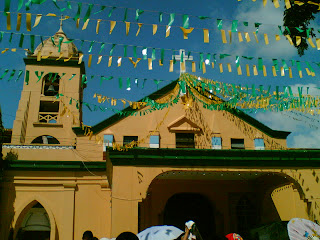



It is just this year that I've been a part of the event from preparation down to the main event including the aftermath. Early this year (lenten season) we (PYM Family) were busy doing the workshop when Wilmer Licup was introduced to me. The meet marks the start of the creation of a museum for the town (Santa Ana). Since then we were busy asking those potentially who has vintage photos to be part of the proposed museum and archives. We also went on tour, Pampanga's Churches and other places in significance such as museums and the Center for Kapampangan Studies.
The 15th day of July, when we re-arranged the altar, to once again (following last year) center the patron saint of the town. We somewhat captured the 1940's look, suggesting the angels up again as they were several years before. The Image of San Joachin was at the altar again for the Image was centered before together with the Image of Santa Ana and Little Mary. The bone marrow relic of Saint Anne placed on an old monstrance completes the grand altar arrangement for the most awaited feast.
The 21st day of July, we were now busy putting up the museum. Fr Roger Yambao lend us the newly constructed Mortuary for a start. The next day (July22, 2007) marks the soft opening of Santa Ana Museum and Archives, right after the first mass (7am, as Fr. Yambao announced to the church goers). At 6pm right after the Youth Mass, Fr. Lansang (our former parish priest) blessed the newly constructed mortuary and parish hall. Too bad I wasn't there to witness the event (family matters), in behalf of the dream team (Commission on Cultural Heritage of Santa Ana) I am very honored to have been a part of the History.
The 25th day of July, the one they known locally as "bisperas", the day I am very sick. Eventhough I still managed to go to work at Paco Park Manila and proceed to the last session of the "Alay sa Mag-aaral" project. This "Alay sa Mag-aaral" project was again one of the very first thru the initiative of our parish priest, those who were at 6th grade were given a chance to:
1. Know the lifestory of Saint Anne with audio visual presentation.
2. Know how the body of Saint Anne was found also with presentation
3. Watch the history of the town from the items we've collected for the museum
4. And experience a tour within the old church including those which were formerly restricted area. Going up the five storey belfry makes their experience worth to remember.
A new Image of Santa Ana was introduced to the public placed at the post of the traditionally known processional Ivory Image. The Image is much bigger and grand, the former was placed at the convent. For the very first time the much bigger Image of Santa Ana was the one used for the Grand procession. The 14 baranggay patron saints were present plus the "Indung Maria" which was dressed into "dela Correa" and "Virgen delos Remedios" of baranggay Santiago was also present. All of the Images counts 17 including Santa Ana. The heavy rain fell that night during the grand procession.
(Special Thanks to: Dianne Patawaran and Anjhine Mallari for the photos herein posted.)










































.jpg)
.jpg)
.jpg)